Do you think all your emails get delivered to your addressee’s main inbox? Are you sure? Here’s some information about email deliverability and how much we should care about it when sending cold emails.
What is email deliverability?
It’s how many of the emails you send actually get to your prospects’ inboxes, or more specifically, how many of the emails get a chance to reach your prospects’ eyes. It refers to the success of an email in reaching its intended recipient’s inbox without being blocked by the ESP.
If the email gets classified as spam, it’s not delivered at all or it’s not delivered where it should be. And so, email deliverability suffers.
The more of our emails are classified as spam, the fewer of them are delivered, and the lower the effectiveness of our campaign (not to mention the reputation of our email address and our domain as a whole).
So…
Can we influence our cold email deliverability?
Yes. We should follow some rules to ensure that our emails are delivered to the place we want them to be: our prospect’s main inbox.
Some of the rules are based on people’s opinions about what we send them, and those are basically common-sense rules. Some of the rules stem from bots’ (or filters’) assessment of the content of our emails and the way we send them.
The general rule that sums up the whole pro-deliverability approach is:
Don’t irritate people and spam filters.
If we want high email deliverability, we need to ensure our prospects do not see our emails as spam. Simply speaking, we want our prospects to like our emails, and we want the filters to classify our messages as “wanted.”
What kind of emails are “wanted”?
- personal
- individual
- relevant
- valuable
- honest and clear
- non-salesy
What kind of emails are “unwanted”?
- impersonal
- bulk
- irrelevant
- worthless
- misleading or confusing
- salesy
Check also:
Why People Hate Cold Emails & How Can We Let Them Love Ours >>
There are two easy ways to get classified as spam:
- An email provider’s filter detects a bot-like behavior, or
- Our prospects see us as spammers, so they manually mark our messages as SPAM.
What’s in it for you?
Below, I listed eleven rules that will help us boost the email deliverability of our cold outreach – that is, help us avoid being classified as spam by both people and bots.
There are more of them, but probably no one knows them all. These are the ones that we can easily and consciously abide by.
Here are the 11 rules within three areas we need to take care of:
Email content
Rule #1: Avoid spammy words
Spammy words irritate both people and anti-spam systems. It’s easy to fall into a trap here, as many of us don’t even realize that spam filters may catch some words we normally use in our emails.
And when it comes to people’s judgment, what sounds totally natural to us may feel pushy and salesy to our prospects. I guess this is something we need to learn by experience and by simply applying some empathetic filters to our copy.
The words that alarm email security can be checked out in some blog posts, like this one:
Should You Worry About SPAM Trigger Words? (Updated)
Lists of spam words are constantly updated. Even common words like “marketing” or “increase” are now on the list. Or your industry words. This is especially prevalent in real estate, tax office, or digital agency, see this: A Pain of Cold Emailing In Finance/Real Estate, and How to Overcome It? >>
Rule #2: Limit links, videos, and pics
I always knew that was a good practice, but I’ve never wondered about the reasons behind that rule. Until now. Here’s what I’ve found out from the Pure360 whitepaper on how to improve email deliverability:
Once upon a time, some “evil geniuses” of spam thought that they could avoid being junked by anti-spam filters for the words in their emails if they didn’t use words per se.
That’s why they started sending messages in the form of huge pictures. When email providers noticed the pattern “huge image, little text”, they added it to their spam protection.
There’s also an interesting section on using links in emails in the same whitepaper, which is why we should be cautious with that.
That’s why putting pics and links in our cold emails may irritate spam prevention of some email providers. And that is why we should limit those to the minimum. Keep things simple, depend on a natural and pure message based on words
If you need more proof, read this: What is the Risk of Putting Image/Video into B2B Email? >>
Rule #3: Beware of irrelevant subjects and messages
This one can make your addressees really pissed off. And pissed addressees will most probably mark your message as spam. The more of them do that, the faster your email domain will get blacklisted.
So don’t make promises about the subject that your message will not keep. Don’t mislead your addressees to get impressive open rates. Focus on the quality of your outreach as a whole. Send messages that are honest and provide real value to your prospects. From the subject to the signature.
For more inspiration for subject lines, check out this blog post.
Rule #4: Pay attention to personalization
How do we recognize bulk messages? They are all the same. Or almost the same. They could be sent to thousands of people with practically no alterations in the body of the message.
And because of the easily recognizable pattern, it’s easy to learn a bot to recognize that as well. Both people and filters get irritated by bulk email leaflets, including impersonal offers.
That’s why it’s crucial to personalize our emails as much as possible. Putting the addressee’s first name at the beginning is not good enough.
When sending a cold email campaign from Woodpecker, I do use templates. But my templates usually involve 3-4 custom fields and snippets, sometimes whole sentences. That allows me to make my messages personal and tailor-made for my prospects.
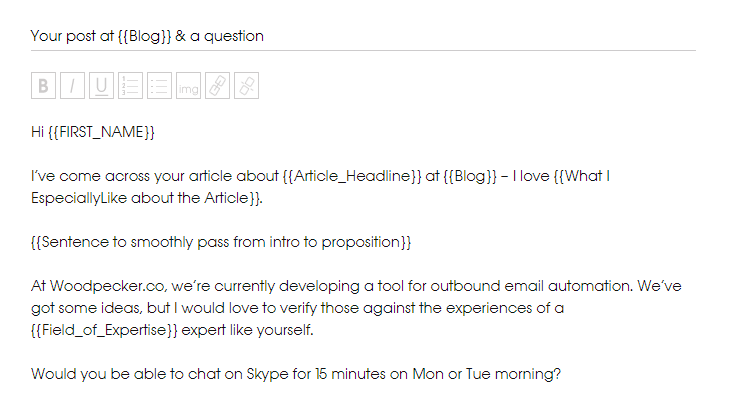
As a result, the prospects feel that they are the center of my message and that I cared enough to find out something about them before I reached out. At the same time, each of the emails sent within the same cold email campaign is different, so the filters accept this as a personal message as well.
People are happy, bots are happy, and I am happy because of high deliverability and high response rates.
To diversify the content of your messages even more, you can prepare different versions of each email in your sequence. Read about how to do that in Woodpecker >>
List of prospects
Rule #5: Make sure you have a good quality list
If we have a low-quality list of contacts – that is, if a significant part of the email addresses we send our emails to don’t exist, lots of our emails will be bounced. The bounce rate affects email deliverability to a great extent. A high number of hard bounces (due to a non-existent email address) may get our domain blacklisted.
That’s why we should always make sure that our contact base is well-verified and up-to-date. You shouldn’t simply guess email addresses.
One of the great things about Woodpecker is that your prospects’ emails are pre-checked before you send them your first email.
The addresses that most probably are wrong or don’t exist are automatically marked as INVALID, and none of our messages will be sent to them to decrease the hard bounce rate to a minimum.
Low bounce rates protect your email domain from getting blacklisted.
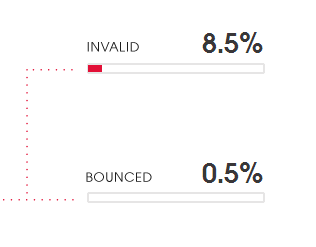
Sending setup
Rule #6: Warm up your email address
If you’ve set up a brand new email address for your outbound email campaigns, it’s important to get it “warmed-up” before sending more messages. That’s email warm-up – you start slow and gradually increase the number of messages sent a day, to make sure your domain won’t get classified as a potential source of spam.
This also stems from the spammers’ practices. How often have you received cold email spam from an email address like [email protected] or [email protected]? Have you ever wondered why people need email addresses with ordinals?
It’s probably because they send hundreds of emails from each of their multiple email accounts, get junked, or banned by their email provider, and they quickly need another email address to send the emails from.
Again, keep it natural when it comes to numbers. How many emails would you be able to send a day if you sent them manually one by one? Focus on quality rather than quantity, and more of your emails will be delivered.
Rule #7: Don’t send many emails at once
That’s a continuation of the previous rule. Bulk emails are sent in batches of hundreds at once. Whichever tool you use to send your emails automatically, make sure it doesn’t send too many messages simultaneously. That’s not human-like behavior. And the filters are sensitive to that.
One significant advantage of Woodpecker is that it sends emails like you would send them yourself. There’s no way Woodpecker will send two messages at the same time.
And the time intervals between consecutive messages will not be identical. For more details, check out one of my previous articles: How Your Emails & Follow-ups Will Be Sent by Woodpecker >>
Rule #8: Send your campaign from multiple mailboxes
Avoid being caught by spam filters and pausing your campaigns. Of course, you should not do this manually, as it is tedious and pointless to copy and paste the same campaigns and then send them from different mailboxes.
Woodpecker allows you to add multiple mailboxes to your campaign and rotate the sending between the added addresses using the Inbox Rotation feature. Since spam filters are getting increasingly brutal these days, it’s better not to exceed sending limits. See how to send from multiple accounts in Woodpecker.
Rule #9: Keep an eye on deliverability – seriously
If your emails stop landing in inboxes, nothing else matters. No opens, no clicks, no replies. Just silence.
The trouble is, deliverability issues don’t come with warning lights. You won’t know your domain’s slipping until it’s too late – maybe a bunch of invalid email addresses, maybe a spike in spam complaints, maybe your SPF record’s off.
Suddenly, your cold emails are going straight to the junk pile.
That’s why Woodpecker’s Deliverability Monitor matters. It checks your bounce rate, sender reputation, and other red flags behind the scenes. So when your reply rate drops, you don’t have to guess why.
To stay clean:
- Block 10 minutes every Monday to check your stats.
- If something looks off, stop the campaign. Fix it.
- Use a mail tester tool to catch spam trigger words and authentication setup issues.
Keep monitoring email deliverability, and your emails will land where they should – right in your prospect’s inbox. Let it slip, and you’re handing control over to junk filters.
Rule #10: Audit your domain before launching
Before sending a single cold email, ensure your domain setup is airtight.
Doesn’t matter how good your email template is – bad SPF, DKIM, or DMARC records will tank your cold email deliverability. Your message won’t even hit the recipient’s inbox. You’ll be filtered out by email providers or dropped into the spam folder before you ever have a shot.
That’s why it pays to run a domain audit. Woodpecker’s Domain Audit tool checks whether your sender policy framework, domainkeys identified mail, and domain-based message authentication settings are in place.
It spots missing records and gives you step-by-step fixes before your cold email campaign goes live.
If you skip this, your outreach will start already flagged, damaging your domain reputation, your sender address, and the IP address you’re sending from.
To lock it down:
- Run a domain audit before sending from any new email account.
- Check that your email authentication is valid across all mail servers you use.
- Use a mail tester website or an email deliverability test tool to validate the setup using free mail accounts.
- Keep a separate sending domain from your main site if you run extensive cold email outreach.
Clean records = positive sender reputation. That’s what keeps you in the primary inbox, not on a blacklist.
Rule #11: Use adaptive sending to stay human-like
If your cold email campaign blasts hundreds of identical emails at perfect intervals, it looks like a bot. That kind of pattern affects cold email deliverability fast. Your emails stop landing in the primary inbox and start piling up in the spam folder.
Adaptive Sending in Woodpecker helps you avoid that.
It paces your emails based on your email deliverability signals – adjusting the volume and gaps between sends. No bulk bursts. No mechanical rhythms. Just realistic sending that keeps your email reputation intact.
It also keeps your IP address, email account, and email server configuration from triggering flags with email service providers or recipients’ mail systems.
And if you pair it with Inbox Rotation, you’re reducing the risk of hitting daily limits across multiple email service providers – all while protecting your domain from being flagged for sending spam.
To do this right:
- Enable Adaptive Sending before every cold email outreach campaign.
- Rotate sending across multiple servers or domain addresses.
- Monitor performance with a mail tester tool and monitor your inbox placement rate.
Filters are built to spot anything that looks mass-produced. Staying human-like is one of the most underrated ways to improve cold email deliverability – and Woodpecker helps you do it automatically.
Most people focus on what to do. But when it comes to cold email deliverability, knowing what not to do can save your domain.
There’s a lot of advice floating around – some of it outdated, some flat-out wrong. And following the wrong tip, even once, can wreck your email reputation without you noticing until it’s too late.
5 myths that hurt your cold email deliverability
Let’s clear up a few common myths that quietly send good emails straight to the spam folder – and what to do instead.
Myth 1: If you’re emailing B2B, you don’t need to worry about consent or unsubscribe links
Even in B2B, ignoring opt-out options is one of the fastest ways to trigger manual spam reports – and those reports are one of the critical factors spam filters track to assess your sender reputation.
It only takes a few annoyed recipients clicking “Mark as spam” to hurt your cold email deliverability and push your messages straight to the spam folder, no matter how relevant your offer is.
Some businesses assume that B2B cold emails don’t require a clear unsubscribe method, but that thinking can backfire. Without one, you deprive your recipients of control, and email service providers notice.
Woodpecker helps you avoid this entirely. You can add opt-out instructions to any cold email campaign, and the platform tracks engagement signals so you can catch deliverability issues early.
Adding a one-click opt-out or a simple “Let me know if you’d rather not hear from me” line shows respect and protects your inbox placement rate.
Myth 2: You can send unlimited emails per day from one inbox if it’s warmed up
Warming up an email account helps build trust, but it doesn’t give you a free pass to send as much as you want.
That kind of activity often leads to blocked sends or account throttling. In some cases, your email provider may suspend your account altogether.
A warm inbox with a solid email reputation can still get flagged if you push too hard. Filters will notice if you’re sending to invalid email addresses or recycling the same message without getting replies.
Here’s a table of some standard limits per provider:
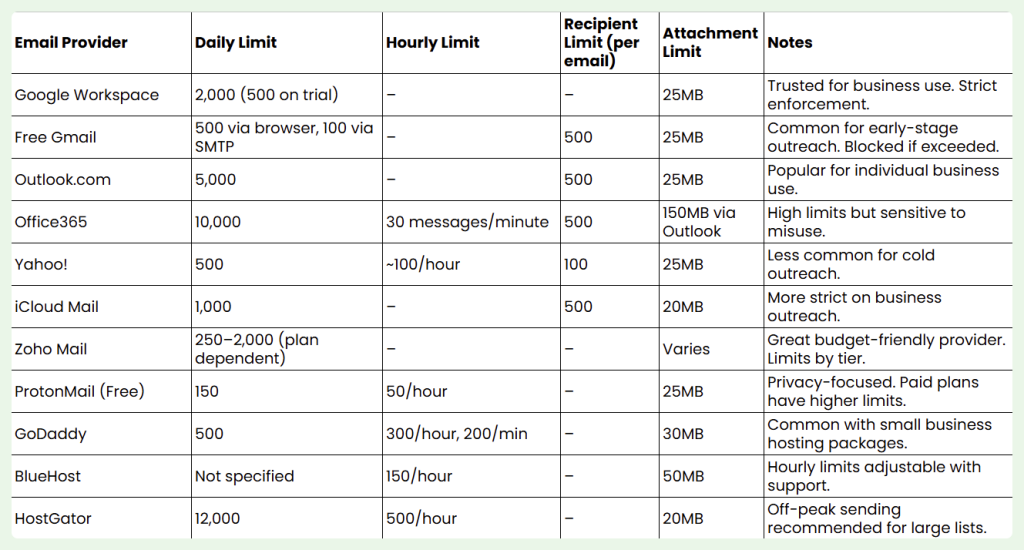
With Woodpecker, you don’t have to guess. Its Adaptive Sending adjusts delivery volume automatically, based on engagement and sending history.
You can also send with a separate email account using Inbox Rotation, keeping your volume healthy and your domain protected.
Pair that with strong email authentication (SPF, DKIM, domain message authentication reporting) and ongoing use of warm-up tools, and your cold email deliverability stays stable – even as your outreach grows.
Myth 3: Sending from a Gmail, Outlook, or other free mail account is fine for outreach
Free accounts might seem convenient for sending cold emails, but they come with a major downside: shared infrastructure.
Your messages are sent from a shared IP address, bundled with thousands of other users – some of whom are likely spammers. Their bad behavior affects your sender reputation, and there’s nothing you can do to fix it.
On top of that, platforms like Gmail and Outlook strictly prohibit large-scale outreach, so your email account could get flagged or suspended even if your content is clean.
To protect your cold email deliverability, send from a domain you control.
Set up a custom domain, authenticate it properly with Sender Policy Framework (SPF) and DomainKeys Identified Mail (DKIM), and configure domain-based message authentication. That way, you’re not relying on someone else’s sending IP address records or risking your messages being flagged by default.
With Woodpecker, you can connect a custom domain and use inbox placement tools to monitor where your emails are landing.
It’s the only way to build a strong, trackable domain reputation and consistently reach your prospects’ inboxes without hoping your email provider plays nice.
Myth 4: If your emails don’t bounce, your deliverability must be fine
Just because your cold emails don’t bounce doesn’t mean they reach the recipient’s inbox. A low bounce rate only confirms that the prospects’ email addresses exist – it says nothing about where your message ends up.
You could be landing in spam, stuck in the “Promotions” tab, or filtered out entirely by email clients. You’re missing most of the picture if you rely on bounce data alone.
To really track cold email deliverability, you need to look at signals like open rates, reply rates, and engagement. Run inbox tests with tools like a spam content detection tool to see if your messages are flagged for spam words or too many links.
Optimize email subject lines, avoid common triggers, and don’t overuse email templates – your spam rate will plummet.
Woodpecker helps you monitor performance across email campaigns, giving you visibility into metrics that affect sender reputation. Combine that with a clean list of verified email addresses and a proper email warm-up routine, and you’ll have a clearer sense of whether your emails are being seen.
Myth 5: Re-engaging cold leads with the same old email won’t hurt anything
If someone didn’t open your first email, sending the same email template again won’t suddenly make it work.
Email clients track engagement signals—opens, replies, clicks—and repeated non-responses tell spam filters that your content isn’t worth delivering.
Keep doing it, and your emails may stop reaching inboxes altogether. Recycling the same message across a list of unresponsive leads can quietly kill your email deliverability over time.
Instead, rethink your strategy.
Update your subject line and rewrite your message. Use smart segmentation. Focus on people who opened or clicked before. For everyone else, drop them or move them to a different flow.
It’s part of having a proper data management system – knowing when to let go instead of dragging your campaign metrics down. And if you’re working within the same domain, avoid using identical content across large lists.
Refresh your messaging and treat each group as unique, not just another batch to collect and blast.
Instead of guessing who deserves a follow-up, use Woodpecker to track engagement and send refreshed messages that feel relevant—not repetitive. This helps you re-engage cold leads without dragging down your deliverability.
***
Hope this helps. Have you experienced problems with your email deliverability? What factors have you found important for high deliverability rate?
FAQ about cold email deliverability
Cold email deliverability refers to how reliably your emails reach the recipient’s inbox – not spam, not bounced, not filtered. Below are some common questions that come up when sending cold emails at scale.
What email deliverability is in cold email?
In cold emailing, email deliverability means your message makes it to the inbox of someone who’s never heard from you before.
It depends on your sender reputation, how well your domain is authenticated, and how recipients react to your emails. Good deliverability ensures your campaign has a real chance to get seen and replied to.
What is the 30 30 50 rule for cold emails?
The 30/30/50 rule is a general benchmark for analyzing cold email performance. Roughly 30% of your success comes from your targeting, another 30% from your message content, and the remaining 50% from your deliverability setup.
That includes proper DNS records (SPF, DKIM, DMARC), email warm-up, and a clean, verified list. Ignore deliverability, and even great content won’t help.
How to check cold email deliverability?
Start by using tools like Gmail Postmaster, Woodpecker’s Domain Audit, or a mail tester to assess your domain reputation, bounce rates, and spam signals.
You’ll also want to check if your SPF, DKIM, and DMARC records are working as expected. Low opens or no replies? That’s another clue you’re not landing where you should.
How to avoid spam in cold emails?
Use verified contacts, avoid spam trigger words, limit links and images, and personalize your content. Make sure your email account is fully authenticated and warmed up.
Don’t send too many messages at once, and never blast the same email to a full list. Tools like Woodpecker can manage pacing, personalization, and testing to help keep you out of the spam folder.
READ ALSO
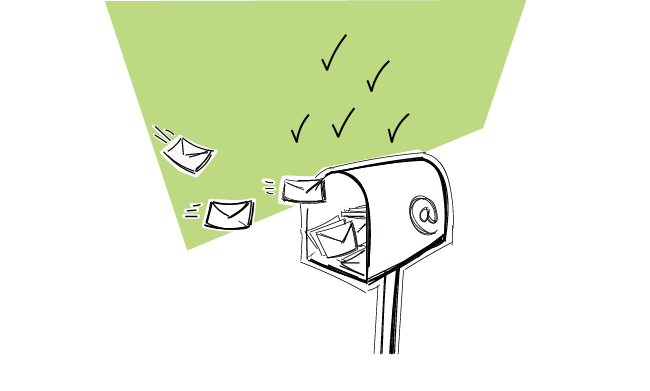
How & When to Test Email Deliverability? List of Tools & Alternatives
Are you taking good care of your cold email campaigns’ delivery rates? There are a few tools our team uses to help Woodpecker customers test email deliverability and improve it. In this post, we share this list with you and explain how & when you can use email deliverability tools by yourself.
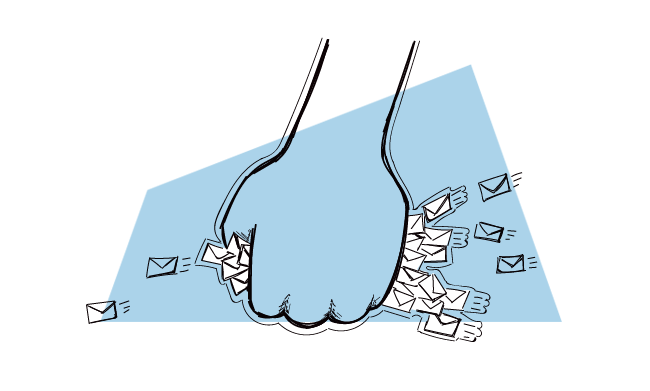
How to Improve Your Cold Email Engagement Rate?
We tend to think about email statistics just from a business perspective. Obviously, we want a 100% open rate and no fewer replies. That would be amazing, wouldn't it? And if it turned out that the majority of replies were positive, we would win. However, the business advantage of getting high email stats is nigh on impossible without taking proper care of email deliverability. Keep on reading to learn how the reply rate affects email deliverability.
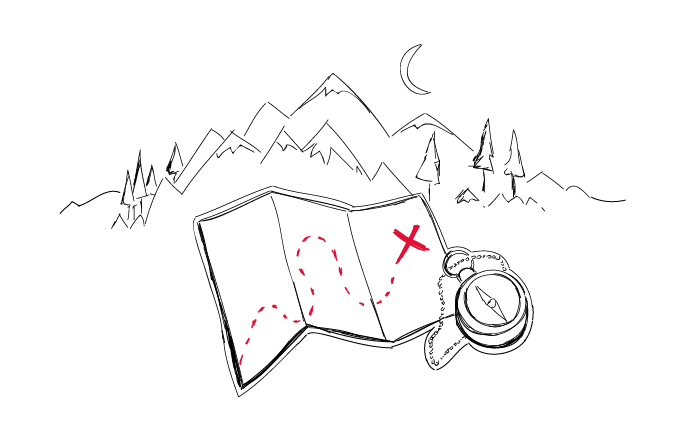
Step-by-Step Practical Guide to a Cold Email Campaign That Gets Delivered
Sending an automated cold email campaign is just a start. In the end, you want your emails to actually get to your prospects' inboxes. And to make that happen, it's crucial that you properly plan and set up your cold email campaign in every detail. I wrote this post in cooperation with our Support team and our Head of Integration & Deliverability, because we observed that many of our users still need help when it comes to properly adjusting their cold email campaign settings.
